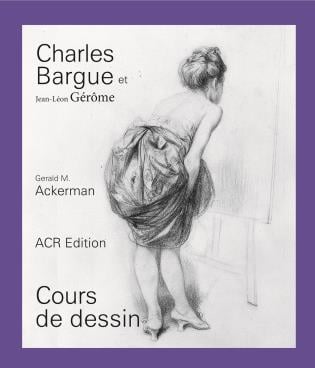
Charles Bargue et Jean-Léon Gérôme
Cours de dessin
- The Bargue-Gérôme Drawing Course is a book that will interest artists, art students, art historians, and lovers and collectors of drawings
- Text in French
The Bargue-Gérôme Drawing Course is a complete reprint of a famous, late nineteenth century drawing course. It contains a set of almost two hundred masterful lithographs of subjects for copying by drawing students before they attempt drawing from life or nature. Consequently it is a book that will interest artists, art students, art historians, and lovers and collectors of drawings. It also introduces us to the work and life of a hitherto neglected master: Charles Bargue.
The Drawing Course consists of three sections. The first consists of plates drawn after casts, usually of antique examples. Different parts of the body are studied in order of difficulty, until full figures are presented. The second section pays homage to the western school of painting with lithographs after exemplary drawings by Renaissance and modern masters. The third part contains almost sixty académies or drawings after nude male models, all original inventions by Bargue, the lithographer. With great care, the student is introduced to continually more difficult problems in the close observing and recording of nature.
Practiced professional artists will see at once the problems of representation that are approached by Bargue, and they will delight in his solutions. Figure painters will copy the plates to keep in tune; so to speak, much as pianists practice the exercises of Czerny before performing Beethoven. Art students will find it a practical and progressive introduction to realistic figure drawing. Art historians can learn by studying these drawings just what was prized in late nineteenth century figure painting. They will recognize the reliance upon tradition by the use of antique sculptures as models in the first part: Antiquity is here used, not to impose a classical style, but as an aid in seeing the structure of the human body with clarity and intelligence. The result is a convergence of Classicism and Realism. There are no numerical proportional charts, perspective boxes or geometrical schemata to memorize. All the techniques and schemata are developed out of and for the object or person in view.
The drawings are splendid; beautiful; not simply products of assiduity, but of careful observation and the wish to transcribe and communicate the beauty of nature and light, as well as the manifold appearances of the human body. These are objectives that will touch and move any careful reader of drawings, and the figurative arts.
Text in French.
The Bargue-Gérôme Drawing Course is a complete reprint of a famous, late nineteenth century drawing course. It contains a set of almost two hundred masterful lithographs of subjects for copying by drawing students before they attempt drawing from life or nature. Consequently it is a book that will interest artists, art students, art historians, and lovers and collectors of drawings. It also introduces us to the work and life of a hitherto neglected master: Charles Bargue. The Drawing Course consists of three sections. The first consists of plates drawn after casts, usually of antique examples. Different parts of the body are studied in order of difficulty, until full figures are presented. The second section pays homage to the western school of painting with lithographs after exemplary drawings by Renaissance and modern masters. The third part contains almost sixty académies or drawings after nude male models, all original inventions by Bargue, the lithographer. With great care, the student is introduced to continually more difficult problems in the close observing and recording of nature. Practiced professional artists will see at once the problems of representation that are approached by Bargue, and they will delight in his solutions. Figure painters will copy the plates to keep in tune; so to speak, much as pianists practice the exercises of Czerny before performing Beethoven. Art students will find it a practical and progressive introduction to realistic figure drawing. Art historians can learn by studying these drawings just what was prized in late nineteenth century figure painting. They will recognize the reliance upon tradition by the use of antique sculptures as models in the first part: Antiquity is here used, not to impose a classical style, but as an aid in seeing the structure of the human body with clarity and intelligence. The result is a convergence of Classicism and Realism. There are no numerical proportional charts, perspective boxes or geometrical schemata to memorize. All the techniques and schemata are developed out of and for the object or person in view. The drawings are splendid; beautiful; not simply products of assiduity, but of careful observation and the wish to transcribe and communicate the beauty of nature and light, as well as the manifold appearances of the human body. These are objectives that will touch and move any careful reader of drawings, and the figurative arts. Text in French.
- Publisher
- ACR Edition
- ISBN
- 9782867702020
- Published
- 27th Feb 2018
- Binding
- Paperback / softback
- Territory
- USA & Canada
- Size
- 9.97 in x 10.79 in
- Pages
- 336 Pages
Our Catalogs
Browse Our Books
Please log-in or create an account to see your recent items.